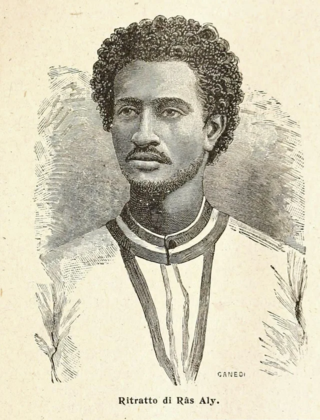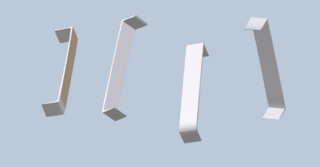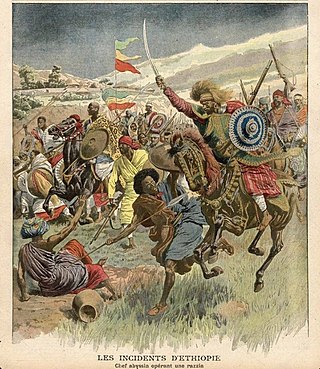
Menelik II, baptised as Sahle Maryam was King of Shewa from 1866 to 1889 and Emperor of Ethiopia from 1889 to his death in 1913. At the height of his internal power and external prestige, the process of territorial expansion and creation of the modern empire-state was completed by 1898.

Tewodros II was Emperor of Ethiopia from 1855 until his death in 1868. His rule is often placed as the beginning of modern Ethiopia and brought an end to the decentralized Zemene Mesafint.

MotiAbba Jifar II was King of the Gibe Kingdom of Jimma.

The Kingdom of Jimma was an Oromo kingdom in the Gibe region of Ethiopia that emerged in the 18th century. It shared its western border with Limmu-Ennarea, its eastern border with the Sidamo Kingdom of Janjero, and was separated from the Kingdom of Kaffa to the south by the Gojeb River. Jimma was considered the most powerful militarily of the Gibe kingdoms.

The Kingdom of Gumma was a kingdom in the Gibe region of Ethiopia that emerged in the 18th century. Its eastern border was formed by the bend of the Didessa River, which separated it from Limmu-Ennarea to the northeast, and the kingdoms of Gomma and Gera to the south. Beyond its northern border were various Macha Oromo groups, and to the west Sidamo groups. Its territory corresponds approximately with the modern woredas of Gechi, Borecha, and Didessa.

The Kingdom of Kaffa was a kingdom located in what is now Ethiopia from 1390 to 1897, with its first capital at Bonga. The Gojeb River formed its northern border, beyond which lay the Gibe kingdoms; to the east the territory of the Konta and Kullo peoples lay between Kaffa and the Omo River; to the south numerous subgroups of the Gimira people, and to the west lay the Majangir people. The native language, also known as Kaffa, is one of the Omotic group of languages.

Ali II of Yejju was Ras of Begemder and the de facto ruler of the Ethiopian Empire. He was a member of a powerful Oromo dynasty known as the Yejju, which ruled much of the Ethiopian Empire during the Zemene Mesafint.

Illubabor was a province in the south-western part of Ethiopia, along the border with Sudan. The name Illubabor is said to come from two Oromo words, "Illu" and "Abba Bor(a)". "Illu" is a name of a clan, and "Abba Bor" was the horse name of Chali Shone, who founded the ruling family of the area when it was conquered by Shewa; hence IlluAbabor means the Illu belonging to Ababor(a).

The Welayta, Wolayta or Wolaitta are an ethnic group and its former kingdom, located in southern Ethiopia. According to the most recent estimate (2017), the people of Wolayta numbered 5.83 million in Welayta Zone. The language of the Wolayta people, similarly called Wolaytta, belongs to the Omotic branch of the Afro-Asiatic language family. Despite their small population, Wolayta people have widely influenced national music, dance and cuisine in Ethiopia.

The Battle of Embabo was fought 6 June 1882, between the Shewan forces of Negus Menelik and the Gojjame forces of Negus Tekle Haymanot. The forces fought to gain control over the Oromo areas south of the Gibe River. The Gojjame forces under Tekle Haymanot were defeated. This is one of the three battles which Donald Donham lists that led to Shewan supremacy over the rest of Ethiopia.
RasGobena Dache was an Oromo military commander for and during Menelik II's reign. He is known for campaigning against Oromo territory to incorporate more lands into the Ethiopian Empire in the late 19th century.

Ethiopia is one of the oldest countries in Africa; the emergence of Ethiopian civilization dates back thousands of years. Abyssinia or rather "Ze Etiyopia" was ruled by the Semitic Abyssinians (Habesha) composed mainly of the Amhara and Tigray, the Cushitic Agaw. In the Eastern escarpment of the Ethiopian highlands and more so the lowlands was the home of the Arab-descended Harari that founded Sultanates such as Ifat and Adal and the Afars. In the central and south were found the ancient Sidama and Semitic Gurage, among others.

Wolayita or Wolaita is an administrative zone in Ethiopia. It is named for the Welayta people, whose homeland is in the zone. Wolayita is bordered on the south by Gamo Gofa, on the west by the Omo River which separates it from Dawro, on the northwest by Kembata Zone and Tembaro Special Woreda, on the north by Hadiya, on the northeast by the Oromia Region, on the east by the Bilate River which separates it from Sidama Region, and on the south east by the Lake Abaya which separates it from Oromia Region. The administrative centre of Wolayita is Sodo. Other major towns are Areka, Boditi, Tebela, Bele, Gesuba, Gununo, Bedessa and Dimtu.

Marchuwa was a currency used by the Kingdom of Wolaita. Marchuwa was a bundle of thin metal strips one cubit long, used as trading currency. Marchuwa was equal to 18 Maria Theresa Thalers or 0.50 US dollars.

Kawo Tona Gaga was the last and most powerful king of the Kingdom of Wolaita. Tona Gaga was the 17th Kawo, or king, of the Tigre dynasty, the last independent dynasty of the Wolayta people. Upon succeeding his grandfather in 1890 he quickly built ties with the Kingdom of Jimma, a tributary of the Ethiopian Empire, marrying the daughter of Abba Jifar II. However, he refused to pay tribute to Shewa He then tried to draw the smaller Omotic Kullo and Konta into his orbit as client states, however, Menelik's cousin Wolde Gyorgis successfully campaigned through both. After six times failed protectorate attempt, Emperor Menelik II reached the border of Wolaita after a two weeks march from Addis Abeba, calling on the king to pay tribute and avoid the destruction of his kingdom. Tona prepared his fortifications and refused negotiation. Expertly dug defensive trenches and mounds crippled the initial assault, but Tona Gaga was eventually pushed out of his strongpoint and caught between the Ethiopians and Oromo auxiliaries sent by Abba Jifar II, who had betrayed Tona Gaga. After his capture in 1894, the ex-king was baptized as Tekle Haymanot and made the governor of his previous dominion. He would later assist Menelik II in multiple campaigns.
Motolomi Sato or Kawo Motolomi Sato was the founder and one of the most famous kings of the Kingdom of Wolaita. He ruled part of present day Ethiopia in the 12th century under the Damot Kingdom under Wolayta malla dynasty. Kawo Motolomi was an expansionist king of Wolaita. The son of king Sato, he was of the indigenous and heroic Wolaitta-Malla family and his family can still be found in Wolaita. The governmental center of the Wolaita during the Motolami era was at the summit of a gorgeous mountain known as Damota, which ultimately became the name of the kingdom. The force of cavalry and infantry besieged Kawo Motolomi's palace, known as Xaazza Garuwaa.
Ogato Sana, also known as Kawo Sana Ogato in the Wolaitta language, was the one of the most renowned kings of the Tigre dynasty along with the Kingdom of Wolaita. King Ogato had acquired all of the regions, not only by battle, but also through deception and the employment of spys among the Gamo, Gofa, Kucha, and Kambata tribes. During his reign, the pre-colonial Wolaita kingdom's agricultural modernization effort included expanding acreage, installing irrigation canals, and improving cattle breeds in order to implement modern dairy farming. King Ogato Sana was 10th rulers of the Wolaita kingdom under the Tigre dynasty. King Ogato had erected his palace at top of the Damot hills, driven the Hadiya people out of the present-day Humbo and Abaya in the north, and captured other provinces. To protect himself from intruders, he erected a fortification around his castle on Damot hill, as well as a defense trench surrounding Sore Mashedo.
Dalbo is a town in Southern Nations, Nationalities, and Peoples' Region, Ethiopia within Wolayita Zone. Dalbo is located about 304 km away from Addis Ababa to the south through Butajira. And the town is located 11 km, North from Sodo, the capital of Wolayita Zone. The coordinate point of the town in map is 6°54′0″N 37°52′0″E with elevation of 2349 meters above the sea level.
Sana Tube, or Tube Sana in the Wolaitta language, was the one of the kings of the Kingdom of Wolaita. He was from the Tigre dynasty. Kawo Sana was the 9th king from the Wolaita Tigre dynasty. During his reign, the pre-colonial Kingdom of Wolaita had fought with the nearby rival peoples and states of Hadiya, Arsi, Gujii, Sidama and Kembata, after he stabilized the kingdom and extended the frontiers to the present areas of Offa, Humbo, Boloso Sore and Damota. The king was highly concerned about the annexation of Wolaita territories by strangers and determined to fight against warriors. He annexed Kulo and Dawuro.

Menelik's Invasions was a series of wars and conquests carried out by Menelik II of Shewa to expand the Ethiopian Empire.














